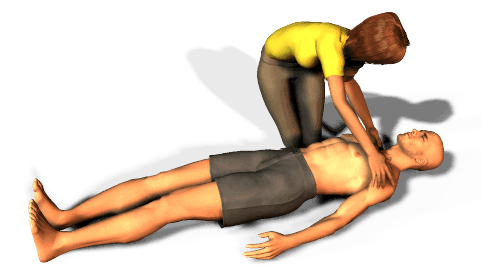Progress
CPR/AED/First Aid | Class Summary
Compression Only CPR
Quality CPR with good compressions in conjunction with adequate ventilations will give your victim the best chance of survival. If you are faced with an emergency situation and do not have proper protective equipment then it is acceptable to do Compression Only CPR. Since this is a professional level course, Compression Only CPR is recommended for rescuers without protective gear. Survival rates are much higher than with no CPR at al. If you have protective gear, provide full CPR. If you do not have adequate protection then provide CPR with normal compressions and no ventilations.
Special Situations
Real world emergencies often take place in “less than ideal” situations. If you are in a remote location you may be unable to activate EMS quickly. In the case of an accident, fire or with multiple victims, you may need to improvise. Priority should be given to the safety of yourself and other rescuers. The important thing is that you do what you can do and be sure to stay within your level of training. We hope that if you are faced with an emergency situation, you can take what you have learned in this course and apply it to the best of your ability.
Coronavirus | Covid-19
Due to the COVID-19 pandemic, we recommend several precautions in addition to using Universal Precautions.
While assessing the victim or providing First Aid
- Follow all Universal Precautions
- Wear PPE including an n-95 mask and gloves
- If possible, have victim wear a mask
- Keep onlookers at least 6 feet from you and the victim
- Limit unnecessary contact with victim
While Performing CPR
- Follow all Universal Precautions
- Wear PPE including an n-95 mask and gloves
- Use a bag valve mask or barrier device
- If a bag valve mask oor barrier device is not available, perform Compression Only CPR
- Keep onlookers at least 6 feet from you and the victim
- Limit unnecessary contact with victim
After Providing CPR or First Aid
- Wash hands and all exposed skin surfaces with soap and hot water as soon as possible
- Dispose of used PPE accordingly
- Sanitize non-disposable protective gear and clothing
- Sanitize surfaces that may have been exposed
- Monitor yourself for symptoms if you know or suspect you have been in contact with a person that has COVID-19. These symptoms include fever, cough, difficulty breathing, and shortness of breath. If any of these symptoms occur, contact your doctor or healthcare provider.
Conclusion
We hope you enjoyed the class. Please feel free to review any part of the class you choose. If you have not viewed the “Key Numbers” page, click on it now. It is a valuable tool and will help you remember what you’ve learned.

Instructor: Mike Figuero
Publish Date: 2023-04-02
Last Updated: 2023-07-18
You have completed the class material.
Click the button below to take the test.